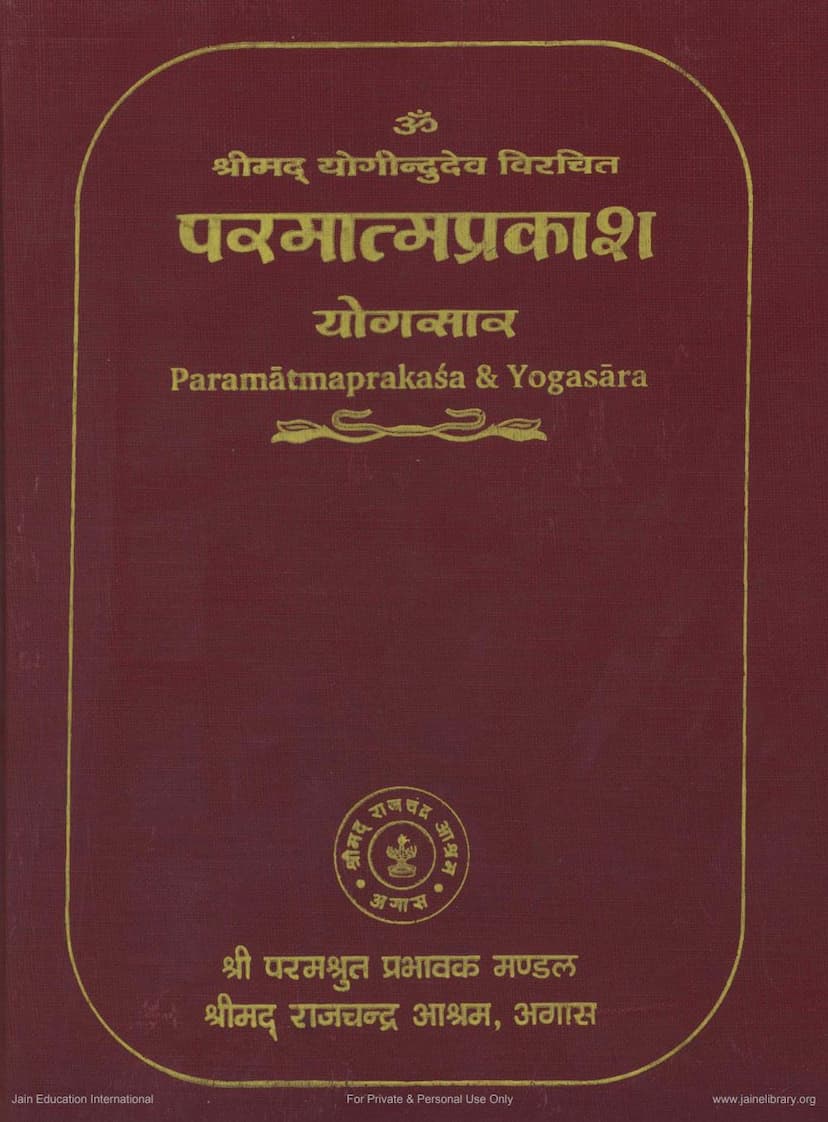Parmatmaprakasha And Yogsara
Added to library: September 2, 2025

Summary
This document is a collection of Jain scriptures, primarily Paramātma-prakāśa and Yogasāra, attributed to Yogindudev. The text is presented with multiple layers of commentary and translation, making it a comprehensive academic and devotional resource.
Here's a breakdown of the key aspects:
Book Title: Paramātmaprakāśa and Yogsara Author(s): Yogindudev, A N Upadhye Publisher: Paramshrut Prabhavak Mandal Catalog Link: https://jainqq.org/explore/001876/1
Core Texts:
- Paramātma-prakāśa (परमात्मप्रकाश): This is the central text, described as an Apabhramsa work on Jain mysticism. It is presented in the Apabhramsa language, with a Sanskrit commentary by Brahmmadeva and a Hindi translation by Daulatarama, further elaborated with a Hindi translation by Pandit Jagadishchandra Shastri. The book emphasizes the spiritual path to self-realization and liberation within Jainism.
- Yogasāra (योगसार): This is presented alongside Paramātma-prakāśa, also critically edited with its Sanskrit shade and a Hindi translation by Pandit Dr. Jagadishchandra Shastri. It complements the spiritual teachings of Paramātma-prakāśa.
Editorial and Publishing Information:
- Editor/Reviser: A.N. Upadhye, a retired Professor of Ardhamagadhi and Professor of Jainology and Prakrit languages, who brought significant scholarly rigor to the edition.
- Publisher: Parama-Śruta-Prabhāvak Mandal, associated with Shrimad Rajachandra Ashram, Agas.
- Editions: The text indicates this is the Sixth Edition, published in the year 2000 (Vikram Samvat 2056 / Shrivir Nirvana Samvat 2526). It notes earlier editions, with the first edition dating back to V.N.S. 2442 / V.S. 1972.
- Commentaries: The work is enriched by:
- Brahmmadeva's Sanskrit Commentary (Sanskrit Vrtti).
- Daulatarama's Hindi Translation (Hindi Bhasha Teeka), which was later modernized into contemporary Hindi by Pandit Manoharlal.
- Pandit Jagadishchandra Shastri's Hindi Translation of Yogasāra, including its Sanskrit shade.
- Introduction: A substantial critical introduction by A.N. Upadhye is a key feature, covering various aspects like:
- Earlier studies and the current edition.
- The text and linguistic deductions of Paramātma-prakāśa.
- A detailed summary of the contents.
- A critical estimation of the work, including its occasion, method, style, and Yogindu's place in Jain literature.
- The philosophy and mysticism explored in Paramātma-prakāśa, including concepts like Vyavahāra and Niścaya, the three aspects of Ātman, and the nature of Paramātman.
- An analysis of the Apabhramśa dialect used and its relation to Hemachandra's Grammar.
- A discussion about the author Joindu (Yogindu), his date, and other attributed works.
- Detailed descriptions of the manuscripts studied and their relationships.
- A critical account of the manuscripts of Yogasāra.
- Language: The primary text is in Apabhramsa, a Prakrit dialect that is an important precursor to modern Indo-Aryan languages. The commentaries and translations are in Sanskrit and Hindi.
- Content of Paramātma-prakāśa: The text delves into Jain mysticism, exploring the nature of the soul (Ātman), the Supreme Soul (Paramātman), karma, liberation (Moksha), and the path to self-realization. It emphasizes detachment, meditation, knowledge, and the ultimate unity of the individual soul with the Supreme Soul, often using symbolic language and analogies. The spiritual journey is depicted as a process of shedding karmic impurities to realize the inherent pure nature of the soul.
- Content of Yogasāra: This text complements Paramātma-prakāśa by further elaborating on yogic practices and mystical insights, guiding the aspirant towards self-realization and inner peace.
Key Themes and Philosophical Underpinnings:
- Mysticism in Jainism: The work highlights the significant role of mysticism within the Jain tradition, demonstrating how spiritual realization is central to the path of liberation, even within a system that is metaphysically pluralistic.
- The Nature of the Soul: It explores the three states of the soul: Bahirātmā (external soul, identified with the body), Antarātmā (internal soul, focused on spiritual practice), and Paramātmā (the realized soul, identified with the Supreme Reality).
- Path to Liberation (Moksha): The text outlines the means to achieve Moksha, emphasizing right faith (Samyakdarśana), right knowledge (Samyakjñāna), and right conduct (Samyakcāritra) as the essential components, ultimately leading to the realization of the pure soul.
- Detachment and Non-attachment: A strong emphasis is placed on renouncing worldly desires, attachments, and external rituals that do not contribute to true spiritual realization.
- The Role of the Guru: The importance of a spiritual preceptor (Guru) in guiding the aspirant on the mystical path is acknowledged.
- Linguistic Significance: The Apabhramsa language used in Paramātma-prakāśa is highlighted for its historical importance in tracing the evolution of North Indian languages.
In essence, this publication offers a scholarly and devotional exploration of core Jain mystical and philosophical principles, presented through the seminal works of Yogindudev, meticulously edited and contextualized by A.N. Upadhye.